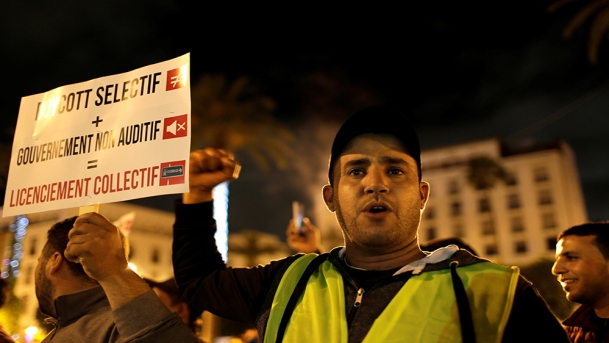
On April 20, 2018, anonymous cyber activists posted calls on social media outlets for a boycott that targeted three companies: Afriquia Gas stations; Sidi Ali bottled water, and dairy products Centrale Danone. The boycott represented a tool of pressure with the aim of dropping the high price of these products, while Moroccans have faced economic hardship in the recent years. The boycotters chose to target these three companies since they symbolize an economy dominated by large groups linked to a business and political elite, or foreign brands. (1) While the declared incentive of the boycott was to serve the consumer’s economic objectives (i.e. the call to decrease the price of the products), it can also be seen as a tool of political engagement (2). It is also a risk-free tool for social and political mobilization that allowed activists to be politically engaged and influential without risking the threat of state repression. As a result, Centrale Danone announced a drop in the price of its dairy products in Morocco September 5. However, the boycotters declined the offer and sustained the standoff.
This paper probes into Morocco’s boycott movement and the nuances of its slogan “Let it Spoil”, by building on the social movements theory (SMT) (3). Leading SMT scholars like Diani and McAdam have argued social movements cannot be reduced to specific forms of disobedience or revolutions, but rather are composed of decentralized and interconnected groups with varying levels of organization that are linked to each other through complex webs of exchanges, either direct or mediated. (4) In recent years, social theorists have focused not only on internal dynamics of these movements, such as the emergence of leaders and internal decision-making process; but, also on the political opportunity that helps activists mobilize resources to achieve the group’s goals. As we will see later, political opportunities are “consistent signals to social or political actors which either encourage or discourage them to use their internal resources to form social movements.”(5)This paper also examines how social change in the Moroccan society has led to the politicization of citizens and how this can explain the boycott’s persistence, its consequences on the political spectrum, and the responses it has elicited from the boycotted companies, the government and the entire regime. At the heart of the analysis, “regular” citizens seem to be the main agents of change, and no longer as merely passive consumers.
The Social movement theory has derived mainly form the work of advocacy groups in Western contexts in the last five decades. However, Iranian-American sociologist Assef Bayat has proposed a more recent concept to analyze the new generation of social movements in the Middle East. What he has termed as ‘social nonmovements’ refer to how ordinary individuals in the Middle East who are not members of the elite are able to change politics through their simple daily routines that take the form of a negative protest against situations and grievances. (6) This concept contests the classical top-down politics and pushes for an alternative bottom-up mobility. As Bayat argues, “These claim-making practices are made and realized mostly through direct actions, rather than through exerting pressure on to authorities to concede—something that the conventionally-organized social movements (like labor or environment movements) usually do. In a sense, the non-movements emerge as an un-articulated strategy to reduce the cost of mobilization under the repressive conditions.” (7)
The Rise of a ‘Shadowy’ Campaign!
Despite previous calls for boycott echoed and failed in Morocco in the past, they seem to have become popular and appealing to many citizens in 2018. In the early 2000s, certain Islamist and secular groups alike called for the boycott of American and Israeli products, such as Coca Cola, McDonalds, Israeli dates, and other products. The Boycott, Divestment and Sanctions movement (also known as the BDS movement) is a good model of such campaigns. However, it failed to provoke good appeal among citizens, expect few groups linked to the leftist and Islamists spectrum. Therefore, the current boycott campaign seems to embody an unprecedented landmark in Morocco’s contemporary political history. For the first time in the sixty-year-post-independence era, millions of Moroccans agreed to boycott specific companies and challenge certain areas of the country’s political economy through the will of Moroccan net citizens and the anonymity of social media.
The ongoing boycott campaign has been more popular than any previous calls for protest. Within two weeks of its launch April 20, 2018, more than 90 percent of Moroccans were aware of the campaign and almost three quarters of citizens participated in some way. Among those who supported the campaign, 95 percent targeted Central Danone, 78 percent targeted Sidi Ali, and 52 percent targeted Afriquia, according to l’economiste. (8)
Interestingly, the boycott seems to be a youth-driven collective action as almost 93 percent of the participants, in a survey commissioned by l’economiste, between 15 and 24 were aware of the boycott campaign. 70 percent within this category actively participated in the boycott. The number falls to 31 percent for the older people ( 55 years old). (9) These results can be explained by the strong mobilization of the youth via various social media platforms in the same is the most affected by current politics. They are the most affected category of citizens by unemployment, which has turned many of them into serving as the driving force in different forms of activism.
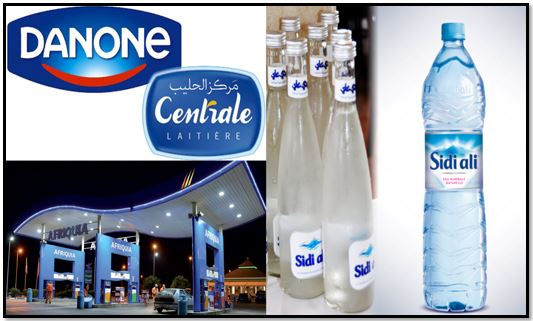 |
| [Getty] |
Morocco’s 2018 boycott campaign represents an exemplary model for mass-led political mobilization and a sign of the emergence of a new generation of social movements in Morocco:
-
It was highly visible as it persisted for several months and resulted in victory when Centrale Danone decided to reduce its prices.
-
It challenged the traditional modes of repression used by the authorities to contain opposition, as it deemed difficult to crush boycott by the traditional tools of repression because of its fluidity and diffusion of the campaign.
-
It showed that boycott is not only a technique used in support of consumer protection efforts; but, also a tool for political mobilization as it that was able to mobilize a large portion of society around an organized cause and how to influence politics out of the “formal” and conventional political institutions. (10)
Political Opportunity for Rebellious Morocco
To help understand why this youth-driven protest has been successful in triggering and enduring the campaign, it is important to look into the political environment and the strategies used by boycotters to achieve their goals. Protestors have profited from a political opportunity that opened up, in late 2016, to enhance their goal. It also used a plethora of tools in order to engage to make their voice heard.
Morocco has had its own version of the so-called ‘Arab Spring’, which remains a struggling social uprising. On February 20, 2011, thousands of protesters took to the street demanding social justice and political reforms in Morocco. The Monarchy in Rabat swiftly responded by proposing certain political reforms including a referendum on a constitutional amendment and holding early elections. The hope that political reforms would be inducive for citizen’s welfare and more liberties seems to have faded away in the last three years. Since 2015, there has been noticeable decline and increasing social malaise, while the Moroccan authorities have shown a more aggressive authoritarian character. This shift has caused more tension and frustration among citizens especially after 2016. The so-called ‘Makhzen’ authorities have returned to the old practices of electoral manipulation and other realpolitik constraints on freedom of protest and freedom of expression.
Since October 2016, Morocco has been shaken by an open-ended wave of protests across the country, either in the northern region Rif, Rabat, Casablanca, or other major cities. Socio-economic issues, such as unemployment, poor basic services, and high cost of living, triggered the protests. Moroccan authorities’ response was excessively repressive which led to massive arrests among protesters, and pushed others to go underground or depoliticize. (11) It seems that the repressive approach was successful in weakening “street protests”. However, a closer look on the trend of political mobilization in 2018 reveals that the protests did not disappear altogether, but rather metamorphosed (12) into new forms of resistance of authoritarianism in Morocco and North Africa as a whole. (13) Accordingly, the boycott campaign might be seen as a new strategy of political engagement in Morocco.
The official repression of street protests in Moroccan cities has refrained many citizens from participating in demonstrations in public squares, as a preventive measure against what is perceived or real threats linked to protests. Hence, boycotting represents an alternative way for citizens to express themselves because of its risk-free nature. (14) As the boycotters did not take to the streets, the Moroccan regime cannot suppress them. This trend also gave the opportunity to many citizens to be promising agents of change without running the risk of being prosecuted or jailed.
As leading social movement theorist Sidney Tarrow argues, contentious politics is triggered when changing political opportunities and constraints create incentives to take actions for actors who lack resources on their own. People contend through known repertoires of contention and expand them by creating innovations at their margins. When backed by well-structured social networks and galvanized by culturally resonant, action-oriented symbols, contentious politics leads to sustained interaction with opponents – to social movements. The opening of opportunities provides external resources to people who lack internal resources. (15)
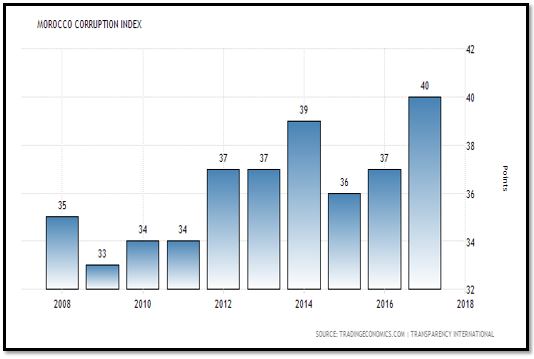 |
| [Transparency International] |
It appears that Tarrow’s concept of structure of opportunities is relevant to the study of Morocco’s 2018 boycott campaign. It is worth mentioning that calls for boycott of some products started one year prior to the current campaign. (16) However, it was only when the political opportunity opened after November 2016 that these calls began to resonate with people. There was growing frustration in Morocco after two major events:
1. There was a political deadlock that started few weeks after the 2016 elections, when the regime, through the financier Aziz Akhanouch-led Rassemblement National des Indépendants (RNI or National Rally of Independents) party, thwarted former Prime Minister Abdelilah Benkirane from building a new government, after his second electoral victory. This showdown of political force led to a political vacuum and distrust in the political process and the intensification of the palace’s domination over the political system. (17)
2. The death of the fish vendor, Mohcine Fikri, in October 28, 2016 inside a garbage compactor, after the local authorities confiscated his fish load of the day, triggered robust protests in the Rif region and elsewhere. Moroccan protesters took advantage of the political vacuum left by Benkirane’s political blockade by the Makhzen, by escalating the tone of protests that has led to massive arrests among protesters in the Rif, including its leader Nasser Zefzafi and 22 others in May 2017. (18) A chain of protests sparked in other regions such as in Jerada in January 2018. Still, the mass arrest of activists since May 2017 has, in fact, deterred many from taking to the streets, as protesting was clearly costly.
These two events help explain why social media alone does not explain the resonance of the boycott among large segments of the population. Social media had been used earlier; but failed to attract citizens. It is then the political opportunity that opened up in the 2017 following the political deadlock, the death of Fikri, and sparking of protests all over the country that might help to understand the resonance of the ongoing boycott campaign.
Strategies of Boycott
Morocco’s boycott campaign has derived from a specific social movement with unknown leadership. Yet, it has developed technics that reflect a certain way of rationality. Initially, the targeted companies have been carefully chosen. Typically, when people boycott products for political reasons, their action is a protest against perceived injustices committed by the corporation that stands to profit. The ultimate goal of the boycott is the termination of injustices. Boycotters in Morocco have aimed at containing three companies for two main reasons:
1) These companies have been were in a position of dominance while controlling more than 50 percent of the share markets of their products. This position allowed alleged complicity in imposing the price out of fair competition. This might be plausible in the absence of the role of the “competition council”, which was suspended since 2013, since King Mohamed did not appoint a new director.
2) These dominant companies have had strong links to the regime in Rabat. Akhanouch and Bensaleh are very rich and very close to Mohamed VI and his friend Fouad Ali El Himma. They are said to be among “His Majesty’s bosses,” politically compliant but economically voracious. (19) Hence, boycotters have perceived them as benefiting from their political capital to maximize their economic interests at the expense of the consumers. Subsequently, boycotters evoked the results of a report, disclosed by the parliament in august 2018, showing an increase in margins earned by fuel distributors since the liberalization of prices in 2015, with some estimates suggest that the fuel distributors companies earned around 17 billion dirhams more than they earned before the abolition of the subsidies on fuel. (20)
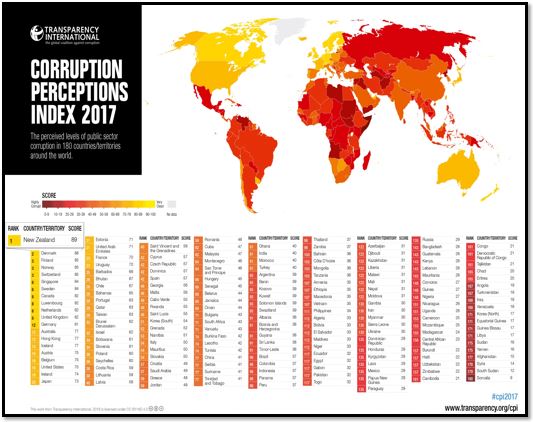 |
| [Transparency International] |
The Art of Framing à la Marocaine!
Morocco’s boycott movement began through Facebook, WhatsApp, and other socialmedia outlets under the hashtags of “Let It Spoil,” “Say No to High Prices”. (21) By late May 2018, the scope of the boycott extended to fish markets due to high prices, and hashtags of “let it rot” and “let it swim” went viral. (22) The strategic use of social media was an effective tool in the boycott campaign as it makes it diffuse and almost impossible to crack it down, as those behind the campaign have remained anonymous, stayed off the streets and been selective in their targets. (23) When the campaign was launched in April, the hashtag “Let It Spoil” went viral on social media, especially on Facebook. Several pages on Facebook were created and sometimes duplicate the same content.
As a convenient platform for spreading the call for the boycott, Facebook allowed ‘free expression’ at the lowest cost. As former member of the ERC-funded project Authoritarianism in a Global Age Kris Ruijgrok argues, the internet has facilitated the occurrence of protests in authoritarian regimes, because the use of the internet has increased access to information in authoritarian regimes despite authoritarian attempts to control cyberspace. (24) In fact, Internet not only offered a wide variety of technical tools for self-expression or mass communication originated by individuals but also enabled public discussion and citizen participation. (25) Moreover, Facebook also provides the opportunity to connect with broad segments of society. Morocco's population of Facebook is about 15 million, (26) the largest of all political parties combined and of the electorate itself, to the level that a scholar predict the emergence of the era of online democracy in Morocco. (27) This allows for a great deal of cost and a little risk compared to classical protest methods.
Even if traditional media still has the power to frame issues and crises, social media has an increasing impact on crisis communication, because ordinary people can participate in crisis framing. (28) The analysis of the campaign on social media reveals that it resonated with regular citizens for two reasons:
1. Its content deemed accessible, as social media itself, is an open source of information.
2. The online campaign deemed effective in not only mobilizing more individuals, but also on sustaining the boycott over time and expanding its radius from big urban cities to remote areas as well. As the movement gained ground, the campaigners' expectations were growing as well. Even if the three companies, tried slow down the boycott movement through multiplying advertising, promotions and press releases, it failed to achieve its goal. (29)
Revenge of the Middle Class?
The open-ended boycott is a manifest of changes in Moroccans’ consumption behavior. For instance, a large segment of the population belongs to the lower or lower-middle-income categories. The Haut Commissariat au Plan (HCP) defined the middle class by household earning a monthly income between 2,800 DH and 6,763 DH. This category represents 53 percent of the population against 34 percent for the lower income class and 13 percent for the wealthy class. (30) Yet, Moroccan’s consumption attitudes have changed since early 2000 with large segments of society increasingly likely to consider taking a loan, which has accumulated to a sum of 4.13 billion USD in 2006 with an increase of 16 percent from 2005. (31)
The social pressure linked to the imperative of taking loans, by heads of many Moroccan households, has lessened and consumers start to believe a limited income is not an obstacle towards getting a comfortable lifestyle. This change in attitude can be seen in the consumption of bottled water. For a long time, mineral water was seen as a luxury item and was used only for special events such as during the visit of a patient or during marriages. The consumption of bottled mineral water increased in recent years in a significant manner. Between 2013 and 2015 the average annual growth rate was 8.95 percent over three years. (32)
This change of consumption behavior reflects both a shift within Moroccan society itself and a crisis in the social ladder. The Moroccan population is more than ever urbanized and its youth more educated. According to the general census in 2014, more than two thirds of Moroccans are urban now, while one third of the population were urbanized in the 1960s. The fertility rate decreased from 6.1 percent in 1960th to 2.1 percent in 2018, and the percentage of unemployment increased among the urban youth to achieve 40 percent in some regions.(33) The national unemployment rate in Morocco was 10.5 percent in 2018, with an estimated 245 thousand working-age people set to join the workforce in 2017-2018. Morocco would need to create 115 thousand additional jobs each year and maintain all current employment opportunities, to remain steady at the current workforce participation rate of 47 percent. (34)
In Morocco as well as in many MENA countries, the better educated you are, the most likely you are vulnerable for unemployment. Among this age category, it is the highest at the national level with more than third of graduates are unemployed. (35) Within this situation, the frustration among urban youth amplified as a result of the government’s inability to address this structural challenge of the economy, as well as a result of the increase of costs of living.
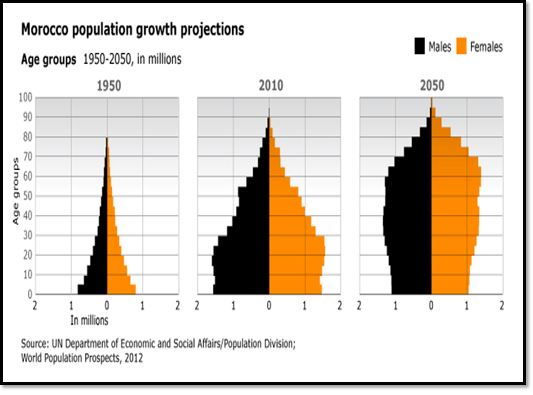 |
| [UN Department of Economic and Social Affairs] |
The evaluation of the boycott campaign results has triggered mixed reactions. From one side, it has had political and economic ramifications. It shook trust in the government’s capacity to protect citizens, lead to firing several ministers, pushed one company to decrease the price of its products. Above all, it demonstrated how regular citizens are able to influence politics in authoritarian set up with limited risks.
The King and his royal entourage made no statement in regards of the boycott campaign. During 2018, King Mohamed was almost absent from the political scene while spending most of his time outside the country. This absence indirectly exacerbated citizen’s frustration, which helps to understand the resonance of the boycott. Protestors wanted to send a strong message to the government and the regime about their malaise.
In Rabat, the government's reaction to the boycott campaign confused many observers. Some ministers tried to convince Moroccans to stop the campaign by highlighting its negative effects on the economy, especially as the campaign started in Ramadan. There was fear it could affect the regular provision of milk. The government also stressed the effect of the campaign on small farmers, (36) as Centrale Danone had already cut by 30 percent the amount of milk it collects from the 120,000 farmers who supply it and lay off workers on short-term contracts, estimated by a government minister at 1,000 people. (37)
During a question-and-answer session at the Parliament in Rabat April 25, Finance minister Mohamed Bousaid (RNI) said “We have to encourage Moroccan companies and products, which is not the case for some morons who are calling for a boycott of structured companies employing staff and paying their taxes.” (38) The word morons (Modawakhine) cost him his position in August when the king sacked him from his position. (39) The Head of Government, Saad Eddine El Othmani, and other PJD ministers asserted inconsistent views on the boycott. (40) It was only the Secretary-General of the Progress and Socialism Party (PPS) Nabil Benabdellah, who supported the campaign.
The government’s multi-positions pushed the boycotters to adopt more hard line positions. For instance, when Lahcen Daoudi, Minister of Governance, protested with Danone workers against the campaign, the boycotters escalated their demands and called for his resignation. (41) Under pressure emanating from “virtual protest”, Daoudi sent his resignation to the Royal Palace a few days later. Yet, the Palace seems to have refused the resignation. But since that incident, Daoudi lost credibility in the eyes of citizens including members of his own party. (42)
Moreover, financier-turned-agriculture minister and head of the BNI political party Akhanouch has been marginalized because of the boycott campaign, after he was considered, for months, as a ‘super minister’ inside the government. His party canceled several planned rallies and meetings with its constituency before making a comeback in n during a public meeting with his party youth September 22. (43) A news outlet even predicted that he was politically “dead”. (44) This statement appears bold because Akhanouch and behind him the Palace, are still in power; and the campaign failed to shake up his power as the main target of the campaign. By October 20, he appeared with the King in an ‘exceptional meeting” to discuss “agricultural employment.” (45)
PR to Dilute the Boycott
The three-targeted companies Afriquia Gas; Sidi Ali, and Centrale Danone have given different responses to the boycott. For instance, the first two ignored the boycott and underestimated its effects. Sidi Ali’s Head of Research and Development Department told a newspaper, “When it comes to the price of water bottles, it is the same for all the brands. We don’t know why consumers chose to get at us and not at the other brands”. (46) Akhanouch showed his solidarity with Centrale Danone by drinking milk in front of cameras. (47)
However, the French company Danone resorted to a different strategy. Its Moroccan market director initially attacked the boycotters and accused them of ‘treason’. (48) This led to a viral online wave of criticism of the company, which pushed him to express an apology for his statement. (49) Few weeks later, the company CEO visited Morocco to led a public relations campaign while communicating with policy makers as well as some relevant actors of the civil society. He promised the boycotters to maintain dialogue and a middle ground solution. After weeks of dialogue with citizens, including boycotters, the company decided to decrease the price of its products in September.
Up to November 2018, it is difficult to assess how much financial harm the campaign has caused to the three companies. According to Central Danone’s own data, the company lost more than a third of its productivity and sales, which is around more than $150 Millions within few weeks after the campaign was launched. It decreased the number of its staff, especially seasonal workers, milk provision from small by third. The exact data about Sidi Ali and Afriquia were difficult to obtain.
Conclusion
The boycott campaign can be seen as an outcry of the Moroccan middle class, that perceives its status and interests as being manipulated by “greedy” political and economic elite. In the last two decades, governmental policies have imposed more burden on the middle class, especially of education and health services.
The boycott is also a sign of structural dysfunctions of mediation mechanisms between the state and society. The domination of the regime over the political sphere has led to an institutional vacuum, that has been exacerbated after the death of Mouhsine Fikri in 2016 the dismissal of Benkirane in 2017. The ‘delegitimization’ of political parties left the palace with no buffer to shield it from citizens’ growing frustration in society.
Yet, the unfulfilled promises of 2011 reversed citizens’ optimism, and hence pushed them to take to the street once again. While Moroccan authorities’ crackdown had intimidated protesters, boycotters learned the lessons and chose a different strategy, which is non-cooperation and economic boycott of the three companies. The boycott has enabled regular folks to be active agents of change and provided them with a strong tool of resistance against authoritarianism: through non-cooperation, powerless citizens are able to fight back by choosing which product they buy and which one they reject.
Yet, it seems that the boycott campaign had its own limits. It failed to achieve its main objective: decreasing the price of all of the three companies with the exception of Central Danone. Also, it seems that it is hard to predict its future. While the campaign is still ongoing, the fact that it has no social movement or identified leadership, its continuity in the near future appears a challenge.
Mohamed Masbah’s chapter “Rise and Endurance: Moderate Islamists and Electoral Politics in the Aftermath of the ‘Moroccan Spring’”Published in “Islamists and the Politics of the Arab Uprisings: Governance, Pluralisation and Contention” (Edinburgh University Press, 2018)
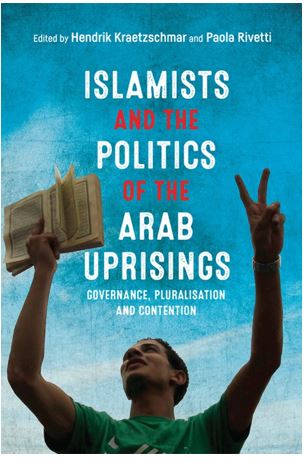 |
| [Book Masbah] |
- “Morocco Consumer Boycott Has Big Business in Its Sights.” Reuters, Thomson Reuters, 30 May 2018, boycott.reuters.com/article/morocco-protests/morocco-consumer-boycott-has-big-business-in-its-sights-idUSL5N1SP35Z.
- John T. Jost, Melanie Langer, Vishal Singh; The Politics of Buying, Boycotting, Complaining, and Disputing: An Extension of the Research Program by Jung, Garbarino, Briley, and Wynhausen, Journal of Consumer Research, Volume 44, Issue 3, 1 October 2017, Pages 503–510, https://doi.org/10.1093/jcr/ucx084
- These theories emerged in the 1970th in a specific political and cultural context characterized by the rise of rise of the civil rights movement in the post-World War II era, such as the Black Movement in the USA as well as the Environmental Movements.
- Mario Diani and Doug McAdam, Social Movements and Networks Relational Approaches to Collective Action, Oxford University Press.2009, p:1.
- Sidney Tarrow, ‘States and opportunities: The political structuring of social movements’, inDoug McAdam, John D. McCarthy, and Mayer Zald, eds., Comparative Perspectives on Social Movements: Political Opportunities, Mobilizing Structures, and Cultural Framings, Cambridge Studies in Comparative Politics (Cambridge [England]; New York: Cambridge University Press, 1996). P: 54.
- Asef Bayat, Life as Politics: How Ordinary People Change the Middle East, Second Edition, Stanford University Press, 2013
- A Few Thoughts on Bayat’s notion of “Social Non-Movements”, Northernsong, June 4, 2014 https://northernsong.wordpress.com/2014/06/04/a-few-thoughts-on-bayats-notion-of-social-non-movements/
- Nadia SALAH, « Enquête L’Economiste-Sunergia/Boycott: Danone, un cas très spécial », l’économiste, N°:5279 Le 24/05/2018. https://boycott.leconomiste.com/article/1028758-enquete-l-economiste-sunergia-boycott-danone-un-cas-tres-special
- Nadia SALAH, « Enquête L’Economiste-Sunergia/Boycott: C’est surtout une affaire de jeunes », l’économiste, N°:5279 Le 24/05/2018.
- John T. Jost, Melanie Langer, Vishal Singh. Op. Cit.
- Mohammed Masbah, A New Generation of Protests in Morocco? How Hirak al-Rif Endures, Arab Reform Initiative, November 2017. https://boycott.arab-reform.net/en/node/1102
- Abdelilah Essatte, Protests of Morocco’s Margins: The Credibility Gap, Moroccan Institute for Policy Analysis, August 2018. http://mipa.institute/5845
- Max Gallien, Is Morocco’s boycott the future of political resistance in north Africa? Middle East Eye, 12 June 2018, https://boycott.middleeasteye.net/columns/morocco-s-boycott-future-resistance-north-africa-1353240629Max Gallien, Op cit.
- Max Gallien, Op cit.
- Sidney G. Tarrow, Power in Movement: Social Movements and Contentious Politics, Rev. & updated 3rd ed, Cambridge Studies in Comparative Politics (Cambridge ; New York: Cambridge University Press, 2011). p: 6.
- The author of this paper received several calls from regular citizens to boycott some products, but it seems that these early calls were not met with serious engagements from citizens.
- Adel Abdel Ghafar and Anna L. Jacobs, Morocco: The king’s dilemma, Brookings Doha Center, March 2, 2017 https://boycott.brookings.edu/blog/markaz/2017/03/02/morocco-the-kings-dilemma/
- Morocco: Rif protest leader Nasser Zefzafi sentenced to 20 years, Aljazeera.com, 27 Jun 2018. https://boycott.aljazeera.com/news/2018/06/morocco-rif-protest-leader-nasser-zefzafi-sentenced-20-years-180627085028471.html
- Omar Brouksy, Morocco: “His Majesty’s Bosses” Boycotted, orientxxi, 7 JUNE 2018, https://orientxxi.info/magazine/morocco-his-majesty-s-bosses-boycotted,2497
- El Mehdi Berrada, Maroc : le Parlement rend public un rapport sur les prix des carburants sur fond de boycott commercial, Jeune Afrique, 17 mai 2018, https://boycott.jeuneafrique.com/560340/economie/maroc-le-parlement-rend-public-un-rapport-sur-les-prix-des-carburants-sur-fond-de-boycott-commercial/
- Chtatou, Mohamed. “Cyber Democracy Slowly but Surely Arrives to Morocco.” Cyber Democracy Slowly but Surely Arrives to Morocco, The Washington Institute for Near East Policy, 3 Aug. 2018, boycott.washingtoninstitute.org/fikraforum/view/cyber-democracy-slowly-but-surely-arrives-to-morocco.
- Ben Saga, Ahlam. “It's Been a Bumpy Ride: A Recap of the Moroccan Boycott.” Morocco World News, 22 May 2018, boycott.moroccoworldnews.com/2018/05/246931/prices-economy-moroccan-boycott/.
- Saleh, Heba. “Morocco's Biggest Businesses Hit by Online Boycott Campaign.”, Financial Times, 7 June 2018, boycott.ft.com/content/1ed8370a-6979-11e8-b6eb-4acfcfb08c11.
- Kris Ruijgrok (2017) From the web to the streets: internet and protests under authoritarian regimes, Democratization, 24:3, 498-520, DOI: 10.1080/13510347.2016.1223630
- Yang Cheng, Jingwen Liang, and Louis Leung, “Social Network Service Use on Mobile Devices: An Examination of Gratifications, Civic Attitudes and Civic Engagement in China,” New Media & Society 17, no. 7 (August 1, 2015): 1096–1116, https://doi.org/10.1177/1461444814521362.
- Internet Users Statistics for Africa, December 31, 2017. https://boycott.internetworldstats.com/stats1.htm
- Chtatou, Mohamed. Op. Cit.
- Päivi Tampere, Kaja Tampere, and Scott Abel, “Who Defines the Narrative of a Crisis? The Case of an Estonian Online Boycott Campaign against an International Supermarket Chain,” Central European Journal of Communication, no. 9.1 (16) (2016): 57–72, https://doi.org/10.19195/1899-5101.9.1(16).4.
- Reda Zairig, “Social Protest in Morocco: Does Mohammed VI Have a Plan?, Middle East Eye,” 29 May 2018, https://www.middleeasteye.net/columns/social-protest-morocco-does-mohammed-vi-have-plan-1200718518.
- Conférence-débat sur les classes moyennes au Maroc, Rabat, le 6 mai 2009. HCP.
- Nicolas Hamelin, Ayantunji Gbadamosi, Sofia Mohaouchane, Imane Benelkaid, Consumers Attitudes towards Debt: Empirical Evidence from Morocco, in ‘Handbook of Research on Consumerism and Buying Behaviour in Developing Nations, IGI Global; 1 edition (May 31, 2016), p 58.
- Joseph oscar GNAGBO, « Eaux Embouteillées : Un marché en pleine croissance », leseco.ma, 30 août 2016 http://boycott.leseco.ma/economie/49247-eaux-embouteillees-un-marche-en-pleine-croissance.html
- General Census, Morocco, 2014.
- “Morocco’s Unemployment on the Rise 2018-2028: Report,” Morocco World News, May 25, 2018, https://www.moroccoworldnews.com/2018/05/247118/moroccos-unemployment-rise-2018-2028-report/.
- “Lahlimi: One-Third of Moroccan Graduates Are Unemployed,” Morocco World News,accessed November 15, 2018, http://www.moroccoworldnews.com/2018/08/251778/lahlimi-one-third-of-moroccan-graduates-are-unemployed/.
- Safaa Kasraoui, Minister Asks ‘Wise’ Moroccans to End Centrale Danone Boycott, Morocco World News, May 13, 2018. https://boycott.moroccoworldnews.com/2018/05/246270/minister-asks-wise-moroccans-to-end-centrale-danone-boycott/
- Ahmed Eljechtimi, “Moroccan Consumer Boycott Pushes Centrale Danone Dairy Firm into the Red”, Reuters, accessed November 15, 2018, https://www.reuters.com/article/morocco-protests-boycott/update-1-moroccan-consumer-boycott-pushes-centrale-danone-dairy-firm-into-the-red-idUSL5N1T64F3.
- Saad Guerraoui, “Boycott Campaign Sparks Heated Debate in Morocco, Arab Weekly,” 20/05/2018, https://thearabweekly.com/boycott-campaign-sparks-heated-debate-morocco.
- Morocco's King Mohammed sacks minister after urging action on economy, reuters, August 1, 2018, https://boycott.reuters.com/article/us-morocco-government/moroccos-king-mohammed-sacks-minister-after-urging-action-on-economy-idUSKBN1KM5FE
- Ben Saga, Ahlam. “It's Been a Bumpy Ride: A Recap of the Moroccan Boycott.” Morocco World News, 22 May 2018, boycott.moroccoworldnews.com/2018/05/246931/prices-economy-moroccan-boycott
- Morocco minister to resign after expressing sympathy for boycott group, MEE and agencies Thursday 7 June 2018, https://boycott.middleeasteye.net/news/morocco-minister-resign-after-expressing-sympathy-boycott-group-1082793647
- Safaa Kasraoui , Minister Daoudi Resigned in June, But Palace May Have Refused It, Morocco World News, Sep 24, 2018 https://boycott.moroccoworldnews.com/2018/09/253947/lahcen-daoudi-resignation-morocco-boycott/
- “A l’université d’été de Son Parti, Aziz Akhannouch Fait Son Come-Back Politique (Vidéo) »Telquel.Ma, septembre 23, 2018, https://telquel.ma/2018/09/23/a-luniversite-dete-de-son-parti-aziz-akhannouch-fait-son-come-back-politique-video_1611656.
- “Aziz Akhannouch Est-Il Politiquement Fini ?,” Le Desk, 02.05. 2018, https://ledesk.ma/enclair/aziz-akhannouch-est-il-politiquement-fini/.
- Tarek Bazza, “King Mohammed VI Receives Akhannouch to Examine Agricultural Employment,” Morocco World News, 20 October 2018,https://www.moroccoworldnews.com/2018/10/255775/king-mohammed-vi-akhannouch-examine-agricultural-employment/.
- Zoubaida Senoussi “Angry Consumers Launch Campaign to Protest Steep Rise in Commodity Prices,” Morocco World News, 25 April 2018, accessed November 15, 2018, https://www.moroccoworldnews.com/2018/04/245107/campaign-sidiali-commodity-morocco/.
- Aziz Akhannouch Reacts to Online Boycott at SIAM, Morocco World News, Apr 26, 2018.
- L’Economiste TV, Boycott : Le Directeur Des Achats de Centrale Danone Présente Ses Excuses, accessed November 15, 2018, https://www.youtube.com/watch?v=TbzRSJV1svo.
- “ Centrale Danone lance une campagne de consultation,” Le Matin, August, 1, 2018, https://lematin.ma/express/2018/centrale-danone-lance-campagne-consultation/298193.html.
